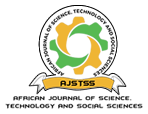Energy efficacy in confined turbulent flow field
DOI:
https://doi.org/10.58506/ajstss.v1i1.68Keywords:
Rayleigh Number, Aspect Ratio, Turbulent flow, confined thermal systems, thermal management, energy- efficacy.Abstract
Problem: Due to ever-increasing technological advancement, household energy consumption has been on the rise globally. This has led to massive depletion of the non-renewable energy sources due to the increased demand for more energy. In confined thermal systems, the high energy consumption is attributed to ineffectual energy distribution mechanisms. Objective: Energy being an essential factor in development, there is need to establish parameters that influence mechanisms of its distribution to obviate this problem. Methodology: The distribution of energy in confined environments is largely associated with the interactions between the fluid particles and the walls of the flow domain. The intricacies of these interactions is responsible for the diversity in energy profiles in thermal systems. The Rayleigh number incorporates these interactions into a single parameter. In fluid dynamics, energy transfer is expressed in terms of the Nusselt number. In confined flow, . The values of the constants C and n respectively depend on the geometry of the flow domain whereas depend on the flow conditions. Since most fluids are of low viscosity, flows encountered in practical applications are mostly turbulent. This paper analyses energy profiles in a turbulent flow in a domain with adiabatic walls for and . The physical laws governing the flow are modeled into a generic equation that incorporates all mechanisms of energy transport. The finite volume method is used to discretize the generic equation due to its ability to adapt a grid structure that captures the local features of the flow domain and the consistence of the final mathematical formulations with the underlying physical laws. The discrete equation is solved iteratively using a segregated pressure-based algorithm. Results: The results revealed that the distribution of energy in the flow field is dependent on the geometrical configurations of the flow domain and the flow conditions. Conclusion: Mechanisms of energy transfer is a function of the Rayleigh number and the Aspect ratio of the flow domain. Application & Recommendation: Aspect ratio and Rayleigh number are the parameters that form a scientific basis for energy management as well as tools for designing thermal systems that enhance energy-efficacy while providing the desired thermal conditions.


